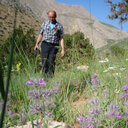Phytochemistry and bioactivity of aromatic and medicinal plants from the genus Agastache (Lamiaceae).
Kata kunci
Abstrak
Agastache is a small genus of Lamiaceae, comprising 22 species of perennial aromatic medicinal herbs. In this article, we review recent advances in phytochemical, pharmacological, biotechnological and molecular research on Agastache. The phytochemical profile of all Agastache species studied to date is generally similar, consisted of two main metabolic classes-phenylpropanoids and terpenoids. In the relatively variable essential oils, most populations of different Agastache species contain over 50 % of a phenylallyl compound-estragole. Also, other volatile compounds (methyleugenol, pulegone, menthone, isomenthone and spathulenol) were reported in various proportions. Major non-volatile metabolites belong to phenolic compounds, such as caffeic acid derivatives, especially rosmarinic acid as well as several flavones and flavone glycosides like acacetin, tilianin, agastachoside, and a rare dimeric malonyl flavone (agastachin). Two unique lignans-agastenol and agastinol-were also isolated. Terpenoids include triterpenoids of oleanane-type (maslinic acid, oleanolic acid and β-amyrin), ursane-type (ursolic acid, corosolic acid and α-amyrin), and typical plant sterols, as well as abietane-type oxidized diterpenes (e.g., agastaquinone, agastol, and others). The bioactivity of various extracts or individual compounds in vitro and in vivo include antimicrobial, antiviral and anti-mutagenic activity, cytotoxic activity to cancer cell lines, and anti-nociceptive, anti-inflammatory, anti-atherogenic, antioxidant as well as biocidal activity to several foodstuff pests. Biotechnological and molecular studies have focused on in vitro propagation and enhancing the biosynthesis of bioactive metabolites in cell or organ cultures, as well as on the expression of genes involved in phenolic biosynthesis.


